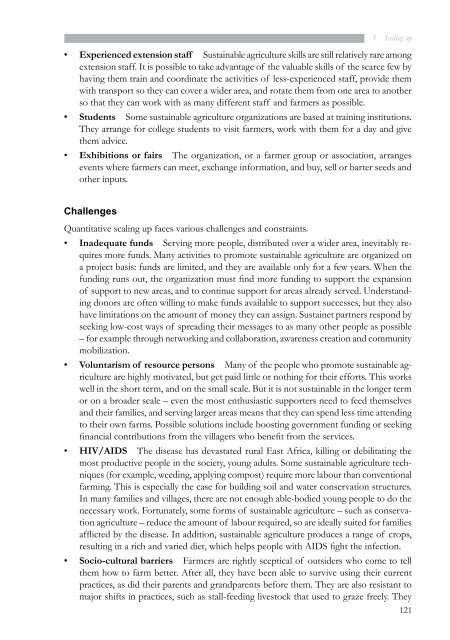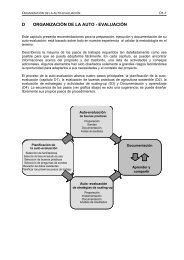cases from tanzania - Sustainet
cases from tanzania - Sustainet
cases from tanzania - Sustainet
You also want an ePaper? Increase the reach of your titles
YUMPU automatically turns print PDFs into web optimized ePapers that Google loves.
5 Scaling up<br />
• Experienced extension staff Sustainable agriculture skills are still relatively rare among<br />
extension staff. It is possible to take advantage of the valuable skills of the scarce few by<br />
having them train and coordinate the activities of less-experienced staff, provide them<br />
with transport so they can cover a wider area, and rotate them <strong>from</strong> one area to another<br />
so that they can work with as many different staff and farmers as possible.<br />
• Students Some sustainable agriculture organizations are based at training institutions.<br />
They arrange for college students to visit farmers, work with them for a day and give<br />
them advice.<br />
• Exhibitions or fairs The organization, or a farmer group or association, arranges<br />
events where farmers can meet, exchange information, and buy, sell or barter seeds and<br />
other inputs.<br />
challenges<br />
Quantitative scaling up faces various challenges and constraints.<br />
• Inadequate funds Serving more people, distributed over a wider area, inevitably requires<br />
more funds. Many activities to promote sustainable agriculture are organized on<br />
a project basis: funds are limited, and they are available only for a few years. When the<br />
funding runs out, the organization must find more funding to support the expansion<br />
of support to new areas, and to continue support for areas already served. Understanding<br />
donors are often willing to make funds available to support successes, but they also<br />
have limitations on the amount of money they can assign. <strong>Sustainet</strong> partners respond by<br />
seeking low-cost ways of spreading their messages to as many other people as possible<br />
– for example through networking and collaboration, awareness creation and community<br />
mobilization.<br />
• Voluntarism of resource persons Many of the people who promote sustainable agriculture<br />
are highly motivated, but get paid little or nothing for their efforts. This works<br />
well in the short term, and on the small scale. But it is not sustainable in the longer term<br />
or on a broader scale – even the most enthusiastic supporters need to feed themselves<br />
and their families, and serving larger areas means that they can spend less time attending<br />
to their own farms. Possible solutions include boosting government funding or seeking<br />
financial contributions <strong>from</strong> the villagers who benefit <strong>from</strong> the services.<br />
• HIV/AIDS The disease has devastated rural East Africa, killing or debilitating the<br />
most productive people in the society, young adults. Some sustainable agriculture techniques<br />
(for example, weeding, applying compost) require more labour than conventional<br />
farming. This is especially the case for building soil and water conservation structures.<br />
In many families and villages, there are not enough able-bodied young people to do the<br />
necessary work. Fortunately, some forms of sustainable agriculture – such as conservation<br />
agriculture – reduce the amount of labour required, so are ideally suited for families<br />
afflicted by the disease. In addition, sustainable agriculture produces a range of crops,<br />
resulting in a rich and varied diet, which helps people with AIDS fight the infection.<br />
• Socio-cultural barriers Farmers are rightly sceptical of outsiders who come to tell<br />
them how to farm better. After all, they have been able to survive using their current<br />
practices, as did their parents and grandparents before them. They are also resistant to<br />
major shifts in practices, such as stall-feeding livestock that used to graze freely. They<br />
121




